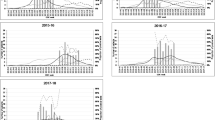Abstract
Children with severe motor intellectual disabilities (SMID) are at high risk of death from acute viral lower respiratory tract infections (LRTI). Although respiratory syncytial virus (RSV) is the most common cause of viral LRTI in children, there have been a few reports on the relationship between SMID and the severity of RSV-LRTI. The aim of the present study is to assess the influence of RSV-LRTI in children with SMID. A case–control study composed of children with SMID (n = 18) and previously healthy children (n = 43) less than 16 years old hospitalized for RSV-LRTI was performed during five consecutive RSV seasons. The clinical presentation and the laboratory data in the SMID group were compared with those in the non-SMID group. In the bivariate analysis, the median age of the SMID group was higher than that of the non-SMID group (p = 0.002). Children with SMID had an increased risk for ventilation support (p = 0.057). The count of neutrophils in the SMID group was significantly increased (p = 0.012), whereas the proportion of bacterial co-infection was lower than that in the non-SMID group (p = 0.005). Multivariate logistic analysis showed that SMID was associated with longer oxygen usage [>7 days: odds ratio (OR) 5.309, p = 0.033]. The present study revealed that children with SMID were prone to developing hypoxia by RSV-LRTI. The strategies for the treatment and prevention of RSV infection need to be improved in SMID children.
Similar content being viewed by others
References
Oshima K (1971) Basic problem of severely mentally and physically disabled children (in Japanese). Koshu Eisei (Tokyo) 35:648–655
Hanaoka T, Mita K, Hiramoto A, Suzuki Y, Maruyama S, Nakadate T, Kishi R, Okada K, Egusa Y (2010) Survival prognosis of Japanese with severe motor and intellectual disabilities living in public and private institutions between 1961 and 2003. J Epidemiol 20:77–81
Wilkesmann A, Ammann RA, Schildgen O, Eis-Hübinger AM, Müller A, Seidenberg J, Stephan V, Rieger C, Herting E, Wygold T, Hornschuh F, Groothuis JR, Simon A; DSM RSV Ped Study Group (2007) Hospitalized children with respiratory syncytial virus infection and neuromuscular impairment face an increased risk of a complicated course. Pediatr Infect Dis J 26:485–491
Welliver RC (2003) Review of epidemiology and clinical risk factors for severe respiratory syncytial virus (RSV) infection. J Pediatr 143:S112–S117
Hall CB, Weinberg GA, Iwane MK, Blumkin AK, Edwards KM, Staat MA, Auinger P, Griffin MR, Poehling KA, Erdman D, Grijalva CG, Zhu Y, Szilagyi P (2009) The burden of respiratory syncytial virus infection in young children. N Engl J Med 360:588–598
The IMpact-RSV Study Group (1998) Palivizumab, a humanized respiratory syncytial virus monoclonal antibody, reduces hospitalization from respiratory syncytial virus infection in high-risk infants. Pediatrics 102:531–537
Feltes TF, Cabalka AK, Meissner HC, Piazza FM, Carlin DA, Top FH Jr, Connor EM, Sondheimer HM; Cardiac Synagis Study Group (2003) Palivizumab prophylaxis reduces hospitalization due to respiratory syncytial virus in young children with hemodynamically significant congenital heart disease. J Pediatr 143:532–540
Greene G, Hood K, Little P, Verheij T, Goossens H, Coenen S, Butler CC (2011) Towards clinical definitions of lower respiratory tract infection (LRTI) for research and primary care practice in Europe: an international consensus study. Prim Care Respir J 20:299–306
Englund JA, Piedra PA, Jewell A, Patel K, Baxter BB, Whimbey E (1996) Rapid diagnosis of respiratory syncytial virus infections in immunocompromised adults. J Clin Microbiol 34:1649–1653
Goodrich JS, Miller MB (2007) Comparison of Cepheid’s analyte-specific reagents with BD Directigen for detection of respiratory syncytial virus. J Clin Microbiol 45:604–606
Yoo SJ, Kuak EY, Shin BM (2007) Detection of 12 respiratory viruses with two-set multiplex reverse transcriptase-PCR assay using a dual priming oligonucleotide system. Korean J Lab Med 27:420–427
Hoshina T, Kusuhara K, Takimoto T, Saito M, Hara T (2010) Identification of bacterial pathogens in pediatric community-acquired lower respiratory tract infection using a simplified procedure of sputum sampling and examination: comparison between hospitalized children with and without underlying diseases. Eur J Clin Microbiol Infect Dis 29:519–525
Keren R, Zaoutis TE, Bridges CB, Herrera G, Watson BM, Wheeler AB, Licht DJ, Luan XQ, Coffin SE (2005) Neurological and neuromuscular disease as a risk factor for respiratory failure in children hospitalized with influenza infection. JAMA 294:2188–2194
Thorburn K, Harigopal S, Reddy V, Taylor N, van Saene HK (2006) High incidence of pulmonary bacterial co-infection in children with severe respiratory syncytial virus (RSV) bronchiolitis. Thorax 61:611–615
Hishiki H, Ishiwada N, Fukasawa C, Abe K, Hoshino T, Aizawa J, Ishikawa N, Kohno Y (2011) Incidence of bacterial coinfection with respiratory syncytial virus bronchopulmonary infection in pediatric inpatients. J Infect Chemother 17:87–90
Power UF (2008) Respiratory syncytial virus (RSV) vaccines—two steps back for one leap forward. J Clin Virol 41:38–44
Semple MG, Cowell A, Dove W, Greensill J, McNamara PS, Halfhide C, Shears P, Smyth RL, Hart CA (2005) Dual infection of infants by human metapneumovirus and human respiratory syncytial virus is strongly associated with severe bronchiolitis. J Infect Dis 191:382–386
De Paulis M, Gilio AE, Ferraro AA, Ferronato AE, do Sacramento PR, Botosso VF, Oliveira DB, Marinheiro JC, Hársi CM, Durigon EL, Vieira SE (2011) Severity of viral coinfection in hospitalized infants with respiratory syncytial virus infection. J Pediatr (Rio J) 87:307–313
Acknowledgments
We thank Tetsuyoshi Sugita (Shimadzu) for the technical assistance with the RT-PCR assay. We also thank Deana Tata for her significant advice regarding the manuscript.
Conflict of interest
The authors declare that they have no conflict of interest.
Author information
Authors and Affiliations
Corresponding author
Rights and permissions
About this article
Cite this article
Onoyama, S., Hoshina, T., Honjo, S. et al. Respiratory syncytial virus infection in children with severe motor and intellectual disabilities. Eur J Clin Microbiol Infect Dis 32, 1353–1357 (2013). https://doi.org/10.1007/s10096-013-1893-x
Received:
Accepted:
Published:
Issue Date:
DOI: https://doi.org/10.1007/s10096-013-1893-x




